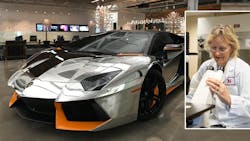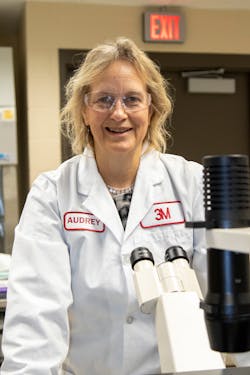A Perfect Bond: An Industrial Scientist Inspires with a Record Number of Patents
Smartphone screen protectors are the sort of modern invention people take for granted. The humble screen protector is for the most part a superfluous, nice-to-have accessory that protects against grime, scratches and minor damage.
But if you’re Audrey Sherman, the inventor behind the adhesive that causes the screen protector to self-adhere to its substrate, it’s no second-stringer.
Aside from making screen protectors stick, Sherman has had a hand in inventions that can be traced to a host of products, ranging from commonplace life hacks to downright genius applications—from ubiquitous sticky tape used for wrapping Christmas presents to the handy Command hook that holds up a towel in a humid bathroom and the breathable, pain-free removable medical tape designed with diabetics in mind.
“Jeopardy!” aficionados would recognize Sherman’s name from the Final Jeopardy clue in an episode last December: “In her 20+ years working for this company, Audrey Sherman of Saint Paul has been granted more than 130 patents.”
The correct response is: “What is 3M?”
To be honored in this way is a remarkable feat for both Sherman and her employer. Each year, more than 4,000 patents are issued to the multinational worldwide. At last count, Sherman, a division scientist in 3M’s Medical Solutions Division, held 139 patents. She is also the only woman among 18 inventors at 3M to ever reach the 100-patent mark.
Original Ideas
Over the course of her career, Sherman has concocted countless formulas for adhesives that are designed to withstand the wear-and-tear of consumer electronic devices, each time reinforcing it with erudite knowledge of the way an invention will impact decisions in material selection, the end-user and environment.
The screen protector formulation Sherman “cooked up” at the 3M lab in Saint Paul, Minn., is described as “an optically clear, curable adhesive including polyvinyl butyral (PVB), a polyurethane (meth)acrylate, a (meth)acrylate monomer and a photoinitiator.” Numerous modifications and variations can be devised from the same pressure-sensitive adhesive (PSA) formulation, but Sherman was given explicit instructions for the adhesive that would become U.S. Patent 8,034,254B2 (“Optical Adhesive for Liquid Crystal Display”).
“One of my managers said it should be easy for my grandmother to drop the film onto the phone, and it would have to do the rest of the work,” recalled Sherman. “It had to be replaceable; it had to be easy for her to peel off and replace with another.” The instruction was to develop an adhesive that had adequate bonding properties, and with no corrosive effect on the components.
Like the Post-it Note, the sticky, viscous material backing the screen protector is repositionable. What distinguishes this PSA, is its “self-wetting” properties; the adhesive requires no pressure and uses the weight of the film itself to spread across the surface of the cellphone before it bonds. The lamination also needed to resist bubbling or cockling.
Sherman characterized its properties as being “closer related to release liner than to pressure-sensitive adhesive,” since it works with the force of surface tension, which pulls the film down and has the strength to hold the film in place. “It behaves like a liquid, but has the internal characteristics of a solid,” she explained. Sherman’s experience straddles the PSA side and release side (preventing stickiness), as well as extrusion-based substrates.
Second Chance Adhesive
For Sherman’s 100th patent, a goal she checked off in 2017, the objective was to develop an adhesive suitable for the electronics industry that could be placed in position and be removed within a certain amount of time. Achieving two contradictory demands—initial low-adhesive strength and final high-adhesive strength—was particularly difficult, said Sherman, who teamed up with a former colleague, Wendi Winkler, for this invention.
The pair developed an a silicone-modified PSA (“Temporarily Repositionable Pressure Sensitive Adhesive,” U.S. Patent 9359531), which was not only optically clear and temporarily repositionable upon lamination, but also able to maintain its optical clarity over the lifetime of the laminated article.
“The adhesive is present at the surface of the laminate, but with time it rearranges and moves away from the surface,” explained Sherman. But while the silicone is present at the surface, it doesn’t adhere immediately. The delay provides a “second chance” to reposition the laminate. Once the silicone settles, the PSA sticks without disturbing any of the optical properties.
The second-chance PSA is useful in applications where product inspections occur during the late stages of a production cycle. In these instances, technicians may place the moisture-resistant protective film on displays and the product can continue to be picked and placed along a production line. When it’s time to inspect the components, the film can be removed readily. “But if the product passes inspection and you leave it there, it is going to really hold on like crazy,” said Sherman.
Persistence Pays Off
To be patentable, a new invention does not necessarily need to demonstrate commercial success, although doing so would be a win-win for any well-established, mature company such as 3M. “The invention has to be good for something,” said Sherman, but the reality is not all brilliant ideas are destined to be commodified.
One patent, in particular, had Sherman stumped. The invention involved a method of modifying light with optical elements (“Method of Modifying Light with Silicone (Meth)Acrylate Copolymers,” U.S. Patent 7998587) having different refractive indices. Optical elements, such as polarizers and diffusers, are used in a variety of applications, such as reducing light intensity and glare in sunglasses.
But in this example, a combination of silicone- and carbon-based adhesive is manipulated so researchers could purposely shape the refractive index regions of the polymers. “We found that we could make the light do amazing things,” mused Sherman. “We understood the physics and chemistry behind it. But to this day we absolutely don’t know what to do with it. We don’t know what it’s useful for.”
Even though U.S. Patent 7998587 won’t be paying dividends anytime soon, creative employees like Sherman aren’t deterred by an invention’s marketable limitations. To the contrary, “3Mers” (3M employees) are encouraged to spend 15% of their working time pursuing their own ideas, said Stefanie Giese-Bogdan, the company’s communications manager.
The policy is rooted in a legacy left behind by Richard Drew, an engineer whose pioneering inventions include Scotch transparent tape and masking tape. Drew’s success was lauded by his manager William L. McKnight, who became general manager at 3M in 1914. McKnight’s philosophy of “listen to anybody with an idea” is touted in business schools as a textbook example of the innovative mindset and a way for companies to nurture opportunities.
Creative Problem Solving
Then there are times when inventions find utility in unexpected ways. Colleagues in 3M’s automotive division reached out to Sherman to inquire about her formulation for a conformable reflective film that could be used to wrap a vehicle. They had figured out a way to create a film wrap that was smooth and not prone to creasing. The problem was that their adhesive caused corrosion and couldn’t withstand the elements (sun, rain, carwashes).
“They called me because they remembered that, while I worked in the electronics unit, I had developed adhesives that didn’t corrode. They needed a pH-neutral adhesive that needed to be good for optics, too. I told them what to use but didn’t hear from them for a long time.”
A year passed before Sherman heard from the patent team. Her polymer idea had panned out and she would be listed as a co-inventor of a highly stretchable film that can be used to conform to the complex surface of a vehicle (“Conformable Reflective Film Having Specified Reflectivity When Stretched at Room Temperature,” U.S. Patent 10162090). The project was a collaboration between Lamborghini and 3M that culminated in the iconic car being wrapped in 1080-GC451 Gloss Silver Chrome.
The Lamborghini project holds special resonance in the inventor’s career track: “That’s my full circle—I cooked up a polymer in the lab for a sports car.” Back in the 11th grade, a 3M scientist named Rebecca Kreckel visited Sherman’s high school and invited students to apply to 3M’s pre-college Science Training Encouragement Program (STEP). “She told us a bit about herself; she cooked molecules all day and she drove a sports car,” Sherman recalled. “That was it for me. I was like, ‘I have to have this.’”
Sherman applied for the internship and subsequently studied chemistry and art at Augsburg College in Minneapolis. Sherman would fortuitously hitch a ride with Kreckel, as she didn’t yet have a driver’s license and her home happened to be on the latter’s route to work. But as soon as Sherman could drive, she purchased her own two-seater—a 1973 Datsun 240Z hatchback.
Wearable Devices
A Wikipedia entry defines the phrase “reinventing the wheel” as duplicating a basic method that has previously been created or optimized by others. It’s an apt saying when applied to Sherman’s move to 3M’s Medical Solutions Division in 2016. At the time, Sherman was briefed on the six core patents (“faces”) that underpin work in the medical solutions division. “Four of them were nine-million numbers, and two of them were seven-million numbers. And I realized this was what they consider their backbone. I thought, ‘seven-million sounds familiar. They’re my two!’”
Published in 2008, one of the patents—U.S. Patent 7407709—is described as “pressure sensitive adhesive compositions comprising an unreactive mixture of polydiorganosiloxane polyurea copolymer, diluent, and silicate tackifying resin. The compositions are useful for articles such as medical devices.”
Even though the move marked an extension of her work, it called for a shift in conceptual thinking. “When I was in the electronics area, moisture was bad because it corroded things and we constantly wanted barriers to moisture,” said Sherman, now fixated on uncovering the best ways to attach one substrate to another while managing moisture more efficiently. “When it comes to skin, moisture is always present. This concept of how we take care of moisture is very complicated.”
The popularity of wearable devices in healthcare has stoked the prominence of adhesives in medical device manufacturing. Globally, the United States remains the largest medical device market and is expected to grow to $208 billion by 2023, according to estimates by SelectUSA, a program led by the U.S. Department of Commerce. Wearables are flexible and have benefits over mechanical fastening systems—there are no holes to drill, they promise improved durability, stress is distributed uniformly and they save time and costs.
As a substrate, the skin’s properties vary from person to person, which present a unique set of challenges for design engineers and medical device professionals alike, ranging from the design and focus of materials, and the conditions the device will be exposed to during use (such as sweating or swimming), to the sterilization and stress forces the device and adhesive material will see during use and removal.
“A medical device could be fitted with the greatest electronics, but if it doesn’t stay in place, it’s game over,” said Sherman, adding that the patient experience is central to her thinking. “My focus now is this concept: If passing moisture through the device is not an option, what are the ways in which moisture gets moved around?”
Moving the Goalpost
Sherman’s background in electronics, durables, industrial adhesives and now medical solutions informs every aspect of what multi-disciplined design engineers aspire to in iterative development processes—deep knowledge of materials, manufacturing processes and scalability of the intended application or product. “[Patent 7407709] talks about seeing what’s ahead, and then trying to get there before the customers are demanding it,” said Sherman, who admits that she values the cross-functional, collaborative nature of her work almost as much as the ambition to find her way to the top of the patent-holders’ leader board.
“Nobody strives to be a goalie to a two-seater car,” she quips.
Still, Sherman is deliberate in harnessing her ambition to take the lead and uses it as a platform for bringing visibility to women’s accomplishments. “Leadership is different than management. Leadership is very natural for women—even for those who do it behind the scenes. It’s great to get that visibility out there because first you see it, then you do it. But you just have to think it’s possible.”
As a scientist, she knows firsthand that inspiration can stem from anywhere; nothing is off-limits. Staring out the window from her lab, she mulls over the notion that she looks to the natural world for insights that might uncover ways moisture collects and runs off in the body—including the way the body’s capillaries transfer nutrients to the bloodstream and the way trees absorb moisture through their root systems.
“Mother Nature only has one answer. She will tell you the answer is ‘no.’ She will tell you what won’t work. Your job is to find what will.”
Highlighted Patents
Audrey A. Sherman, “Optical Adhesive for Liquid Crystal Display,” U.S. Patent 8,034,254B2, Oct. 11, 2011.
Audrey A. Sherman and Wendi J. Winkler, “Temporarily Repositionable Pressure Sensitive Adhesive,” U.S. Patent 9359531, June 7, 2016.
Audrey A. Sherman, “Method of Modifying Light with Silicone (Meth)Acrylate Copolymers,” U.S. Patent 7998587, Oct. 31, 2007.
Joan M. Frankel, et al., “Conformable Reflective Film Having Specified Reflectivity When Stretched at Room Temperature,” U.S. Patent 10162090, Dec. 25, 2018.
Zhou, Zhiming, et al., “Silicone pressure sensitive adhesive and articles,” U.S. Patent 7407709B2, Aug. 4, 2008.
About the Author

Rehana Begg
Editor-in-Chief, Machine Design
As Machine Design’s content lead, Rehana Begg is tasked with elevating the voice of the design and multi-disciplinary engineer in the face of digital transformation and engineering innovation. Begg has more than 24 years of editorial experience and has spent the past decade in the trenches of industrial manufacturing, focusing on new technologies, manufacturing innovation and business. Her B2B career has taken her from corporate boardrooms to plant floors and underground mining stopes, covering everything from automation & IIoT, robotics, mechanical design and additive manufacturing to plant operations, maintenance, reliability and continuous improvement. Begg holds an MBA, a Master of Journalism degree, and a BA (Hons.) in Political Science. She is committed to lifelong learning and feeds her passion for innovation in publishing, transparent science and clear communication by attending relevant conferences and seminars/workshops.
Follow Rehana Begg via the following social media handles:
X: @rehanabegg
LinkedIn: @rehanabegg and @MachineDesign




